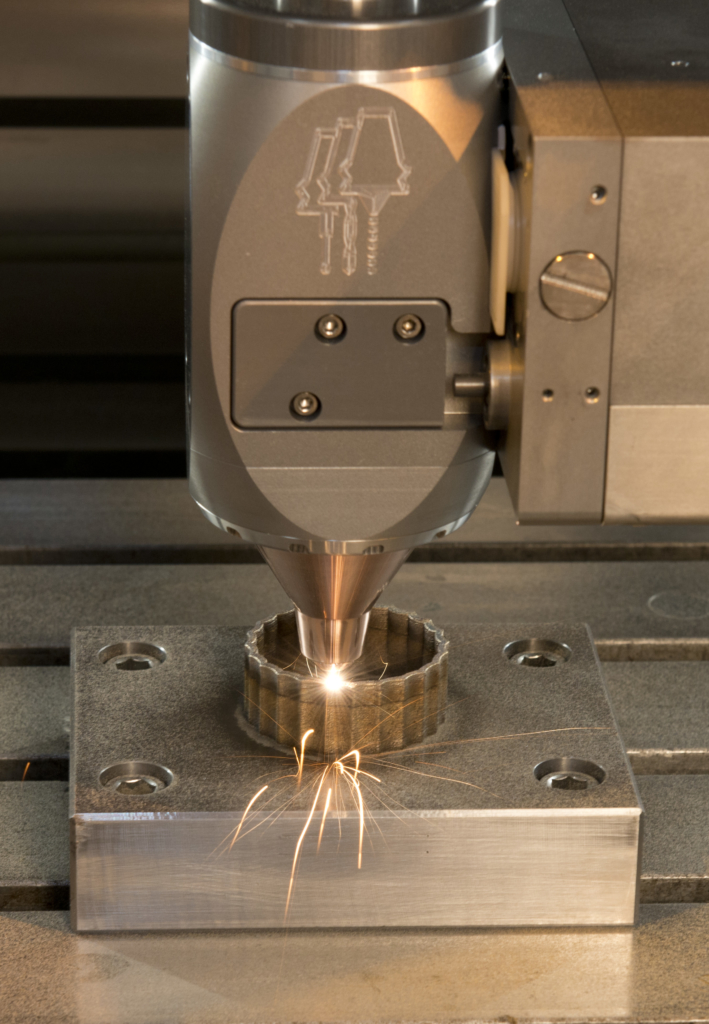By Lynn Gorman
Mitsui Seiki USA, Inc., one of the leading builders of machine tools in the “high precision” category, has developed new machining technology that successfully combines both an additive and subtractive process on one machine tool platform. Named the Vertex 55X-HA, the new “hybrid” technology was introduced at IMTS recently in Chicago. Robb Hudson, Technology & Business Development Manager, gave demonstrations of the new machine during the show and also gave more formal presentations at the official IMTS Conference track as well as the Industrial Laser Conference.

The basic concept of Mitsui Seiki’s new Vertex 55X-HA combines a precision-built traditional CNC vertical machining center with a spindle-adapted laser DED (Direct Energy Deposition) / powder feed nozzle. Parts can be 3D printed from nothing or material can be added to existing parts. The nozzle loads into the tool changer like any conventional tool and is changed automatically via the CNC program prompts, a milling/drilling tool replaces it and aspects of the workpiece can be machined conventionally – including internal features. For example, perhaps surface work needs to be machined before the next layer of material is added. Or, the workpiece can be printed to completion and then subsequent machining operations can be accomplished.
“The process is under full adaptive control as we are making the part, ensuring that as we’re moving back and forth between additive and subtractive, we are maintaining the intended surface or feature as it’s being produced,” said Mr. Hudson. “In addition to developing the integrated spindle-adapted fiber laser and powder-feed system, this is the main benefit that Mitsui Seiki offers as compared to other hybrid systems on the market: our machine maintains common center line integrity between nozzle and tool as users go back and forth between the additive nozzle and the subtractive tool and offers a sub-15 micron volumetric accuracy within the work envelope.”
Generally, coolant and lasers don’t get along well, however as part of the research of additive/subtractive processing at Mitsui Seiki’s headquarters in Japan, the company has developed a process for using flood coolant extensively within a cycle that also includes additive layering. In this technique, an air blow-off operation removes much of the volume of coolant still clinging to the part, followed by the laser applied at a wide focus to dry off the rest. The surface is now prepared for a new feature to be added to it via laser cladding.
The machine also needs protection from the minute powder particles; it’s impossible to filter them all, and one of the hallmarks of a Mitsui Seiki machine tool is its mechanical accuracy, particularly its precision-ground ballscrew and way components. To protect those sensitive attributes, the company modified special guarding and other protections that it engineered in the past for machining centers used in graphite milling, such as EDM electrodes.
Customers can choose either a CAT or HSK spindle that offers 15,000 to 30,000 rpm. Further, Mitsui Seiki has integrated a coolant system for either dry or wet machining best practices. The working range is from 550 mm to 750 mm in X-axis; 600 mm to 800 mm in Y-axis; and 400 mm to 750 mm in Z-axis. Ultimately, most all of the company’s machines will be able to be equipped with the new hybrid technology, including its large trunnion-style machining centers.
Mr. Hudson sums up the benefits to be: a highly productive and repeatable process; good surface finish results; significant reduction of long cycle times attributed to powder bed additive processes; reducing the waste of expensive materials; a one-setup and two-process system on a single platform; a common, adaptive programming language that allows the movement between additive to subtractive seamlessly; machining of IDs and ODs on the workpiece; freedom to add multiple nozzles for different powder flow rates and different angle heads; exact control of the powder flow deposition rate using a variety of laser beam profiles; and the inherent benefits of an ultra-precise and well-constructed machine tool.
The applications ideally suited to Mitsui Seiki’s particular hybrid machining solution include the repair of a number of different types of airfoil parts, such as high-pressure turbine and compressor blades, low pressure blades, blisks/IBRs and impellers for the aerospace, power generation, and oil and gas industries. Further, as large truck and off-road equipment OEMs use more super hard materials in the production of parts and diesel engines, hybrid technology is ideal for repair operations in those industries as well. General part recovery is another area where hybrid machinery could be used to great advantage in traditional machining environments where a scrapped part can cost a company up to hundreds of thousands of dollars.
According to Mr. Hudson, the future holds great promise for the expansion of hybrid technology. “Over time we will likely see hundreds of additional application opportunities in multiple industries. In the very near future we will be able to add nozzles for localized heat treatment, cleaning the workpiece surface, drying the part of coolant residue, and even laser drilling and cutting. The possibilities are virtually endless.”
Lynn Gorman is the marketing communications representative for Mitsui Seiki.





